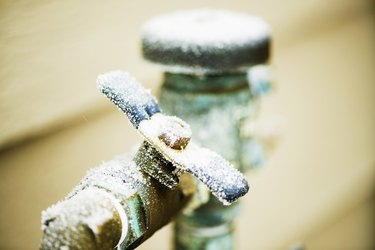Tips to Maintain Pipes from Cold Weather Issues: Crucial Guidance
Tips to Maintain Pipes from Cold Weather Issues: Crucial Guidance
Blog Article
Were you looking for help involving Helpful Tips to Prevent Frozen Pipes this Winter?
:strip_icc()/snow-outdoor-faucet-pipes-4af65d1e5e904fb1aa7bf74071fe5d89.jpg)
Cold weather can wreak havoc on your plumbing, specifically by freezing pipelines. Below's just how to prevent it from taking place and what to do if it does.
Intro
As temperatures decrease, the threat of frozen pipes boosts, potentially resulting in costly fixings and water damages. Recognizing how to stop icy pipes is essential for house owners in cool environments.
Avoidance Tips
Protecting vulnerable pipes
Wrap pipes in insulation sleeves or make use of warm tape to secure them from freezing temperatures. Focus on pipelines in unheated or external areas of the home.
Home heating strategies
Maintain indoor areas adequately heated up, specifically locations with plumbing. Open cabinet doors to allow warm air to flow around pipes under sinks.
How to determine icy pipes
Seek reduced water circulation from faucets, unusual smells or sounds from pipes, and noticeable frost on exposed pipes.
Long-Term Solutions
Architectural changes
Take into consideration rerouting pipes far from outside wall surfaces or unheated areas. Add extra insulation to attic rooms, basements, and crawl spaces.
Updating insulation
Purchase premium insulation for pipelines, attic rooms, and walls. Appropriate insulation aids preserve regular temperature levels and decreases the threat of icy pipes.
Securing Outdoor Pipes
Yard tubes and exterior faucets
Disconnect and drain garden hose pipes before wintertime. Install frost-proof spigots or cover outdoor faucets with protected caps.
Recognizing Frozen Pipelines
What creates pipes to freeze?
Pipes freeze when revealed to temperature levels listed below 32 ° F (0 ° C) for extended periods. As water inside the pipelines ices up, it expands, taxing the pipeline walls and possibly creating them to break.
Threats and problems
Icy pipelines can bring about water supply disruptions, home damage, and pricey repair services. Burst pipelines can flood homes and create substantial structural damages.
Signs of Frozen Piping
Determining frozen pipelines early can stop them from breaking.
What to Do If Your Pipelines Freeze
Immediate activities to take
If you presume icy pipes, maintain faucets open to eliminate stress as the ice melts. Make use of a hairdryer or towels soaked in hot water to thaw pipes slowly.
Final thought
Stopping icy pipes calls for proactive actions and fast actions. By recognizing the causes, signs, and safety nets, property owners can protect their pipes during winter.
5 Ways to Prevent Frozen Pipes
Drain Outdoor Faucets and Disconnect Hoses
First, close the shut-off valve that controls the flow of water in the pipe to your outdoor faucet. Then, head outside to disconnect and drain your hose and open the outdoor faucet to allow the water to completely drain out of the line. Turn off the faucet when done. Finally, head back to the shut-off valve and drain the remaining water inside the pipe into a bucket or container. Additionally, if you have a home irrigation system, you should consider hiring an expert to clear the system of water each year.
Insulate Pipes
One of the best and most cost-effective methods for preventing frozen water pipes is to wrap your pipes with insulation. This is especially important for areas in your home that aren’t exposed to heat, such as an attic. We suggest using foam sleeves, which can typically be found at your local hardware store.
Keep Heat Running at 65
Your pipes are located inside your walls, and the temperature there is much colder than the rest of the house. To prevent your pipes from freezing, The Insurance Information Institute suggests that you keep your home heated to at least 65 degrees, even when traveling. You may want to invest in smart devices that can keep an eye on the temperature in your home while you’re away.
Leave Water Dripping
Moving water — even a small trickle — can prevent ice from forming inside your pipes. When freezing temps are imminent, start a drip of water from all faucets that serve exposed pipes. Leaving a few faucets running will also help relieve pressure inside the pipes and help prevent a rupture if the water inside freezes.
Open Cupboard Doors
Warm your kitchen and bathroom pipes by opening cupboards and vanities. You should also leave your interior doors ajar to help warm air circulate evenly throughout your home.

I discovered that write up about Helpful Tips to Prevent Frozen Pipes this Winter when doing a search on the web. Are you aware of somebody who is inquisitive about the niche? Feel free to share it. I appreciate reading our article about Preventing and dealing with frozen pipes.
Go Deal Report this page